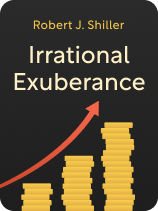

This article is an excerpt from the Shortform book guide to "Irrational Exuberance" by Robert J. Shiller. Shortform has the world's best summaries and analyses of books you should be reading.
Like this article? Sign up for a free trial here.
What caused the dotcom boom and bust? How does the theory of speculative bubbles explain what happened?
The dotcom boom and bust was caused by feedback loops in which investors responded to increasing prices by pushing prices even higher. To understand how this happened, we need to take a closer look at each factor that influenced how investors speculated.
Continue reading to learn what caused the dotcom bubble to form and then burst in the early 2000s.
The Dotcom Bubble
The dotcom boom and bust of the early 2000s and other speculative bubbles are made possible by feedback loops. Feedback loops in investing markets reinforce the price changes caused by new financial information, leading to disproportionate price increases.
How Feedback Loops Create Speculative Bubbles
When relevant information drives a security’s price higher, that price increase itself often spurs further price increases, creating a feedback loop. These loops can occur for various reasons. For example, if investors learn that Netflix’s stock has risen consistently over the past year, they might expect further increases going forward, leading them to purchase more Netflix stock and drive the price even higher.
(Shortform note: Feedback loops can also be driven by a herd mentality—a phenomenon in which investors all mindlessly buy or sell the same security, assuming that others have done the relevant research. For example, if the price of Amazon were rising sharply, many investors might assume that those purchasing Amazon have done so for good reason, causing them to unreflectively buy Amazon themselves and drive its price up further.)
As evidence that such feedback loops can occur, Robert J. Shiller points to Ponzi schemes. These schemes initially rely upon a plausible (but specious) investment opportunity. For instance, ex-lawyer Scott Rothstein offered investors the opportunity to purchase shares of legal settlements, promising them a profitable return when he won the settlement. Then, the scheme’s perpetrator convinces a second round of people to invest, using these new funds to pay the first round of investors. Then, once people hear about the success of the initial investors, that leads to a third round of investors whose funds are used to pay the second round. And so on.
(Shortform note: Despite being the most well-known type of financial scam, Ponzi schemes continue to abound in the US, with researchers estimating that investors collectively lost over $5 billion to Ponzi schemes in 2022. These researchers note that a quarter of these Ponzi schemes involved cryptocurrency. Some analysts even believe that Sam Bankman-Fried’s alleged fraud while at FTX—in which he supposedly used billions of dollars from FTX users to fund speculative investments at his private trading firm—was essentially a Ponzi scheme.)
If you replace the specious investment opportunity with genuine financial news about a security, you can understand how feedback loops afflict investment markets. When investors hear auspicious news about a stock, they bid up its price. Then, when a second round of investors hear about the price increase, they also decide to invest, causing a further price increase. Through iterations of this process, securities’ prices can rise significantly higher than would be rationally justified by the initial news.
(Shortform note: Experts point out that in the world of professional trading, investors aren’t merely reacting to news about a security, but rather the event itself—even before it’s being reported by mainstream news outlets. In other words, professional investors aim to predict what will be reported by news outlets so that they can trade on this information before it reaches amateur investors’ ears.)
Case Study: The Factors Behind the Dotcom Boom
To determine which kinds of specific information can spark these feedback loops, let’s examine the perceptions that set the stage for the dotcom boom. We’ll focus on three key ones: the internet, the Baby Boom, and the creation of 401(k)s.
Factor #1: The Internet
In the 1990s, investors expected the burgeoning internet to drive unprecedented economic growth. This narrative took root because impressive corporate earnings growth in 1994 through 1996 seemingly occurred in lockstep with the growth of the internet—though the internet actually had little to do with it, as internet companies were not yet turning large profits. But, because investors’ perceptions drive stock prices, rather than the reality itself, the internet’s perceived economic import spurred investors to purchase technology stocks.
(Shortform note: Researchers point out that one reason why early internet stocks soared to such high valuations is because of a perceived first mover advantage—the notion that being one of the first companies to use a new technology provides a crucial advantage over competitors. However, they argue that the supposed first mover advantage of early internet companies was overstated: In fact, these early companies suffered a strategic burden because they didn’t yet understand how best to monetize the internet.)
Factor #2: The Baby Boom
Inflated economic expectations because of the Baby Boom (the US population surge following World War II) created heightened confidence that left the market ripe for speculation. He relates that several pervasive theories linked the Baby Boom with economic prosperity in the 1990s. For example, one theory held that Baby Boomers—who began preparing for retirement in the ’90s—would purchase stocks to fund their retirement accounts, leading to widespread stock market growth. Another theory held that Baby Boomers would invest aggressively because they hadn’t experienced the economic turmoil of the Great Depression, and that this investment would lead to price hikes.
(Shortform note: According to analysts, one corollary of the theory that Baby Boomers’ retirement investments would increase stock prices in the ’90s is that, as Baby Boomers liquidate their accounts in the 2020s to fund their retirement, the stock market should drop because of this widespread selling. However, others argue that because markets are efficient, this potential for widespread selling is already priced into the stock market, meaning a stock market crash is unlikely even if Baby Boomers do liquidate their retirement funds.)
Factor #3: The Beginning of 401(k)s
Finally, in 1982, the first 401(k) plan was created, giving employees the chance to allocate some of their income to a retirement fund split between stocks and bonds. As 401(k)s became more popular, they increased employees’ exposure to the stock market, creating a new generation of would-be investors. Consequently, demand for stocks increased, providing further fuel for price increases.
(Shortform note: Since the onset of 401(k) plans in 1982, a wide array of retirement plans have become available to investors, each with its own pros and cons. For instance, a traditional individual retirement account (IRA) allows investors to make tax-deductible contributions to their retirement funds, though withdrawals in retirement are subject to income tax. By contrast, a Roth IRA doesn’t allow for tax-deductible contributions to a retirement fund, but withdrawals in retirement are tax-free.)

———End of Preview———
Like what you just read? Read the rest of the world's best book summary and analysis of Robert J. Shiller's "Irrational Exuberance" at Shortform.
Here's what you'll find in our full Irrational Exuberance summary:
- That financial markets are rife with speculation
- The three key US financial markets where speculative bubbles have formed
- Recommendations to financial leaders and the public for mitigating bubbles






